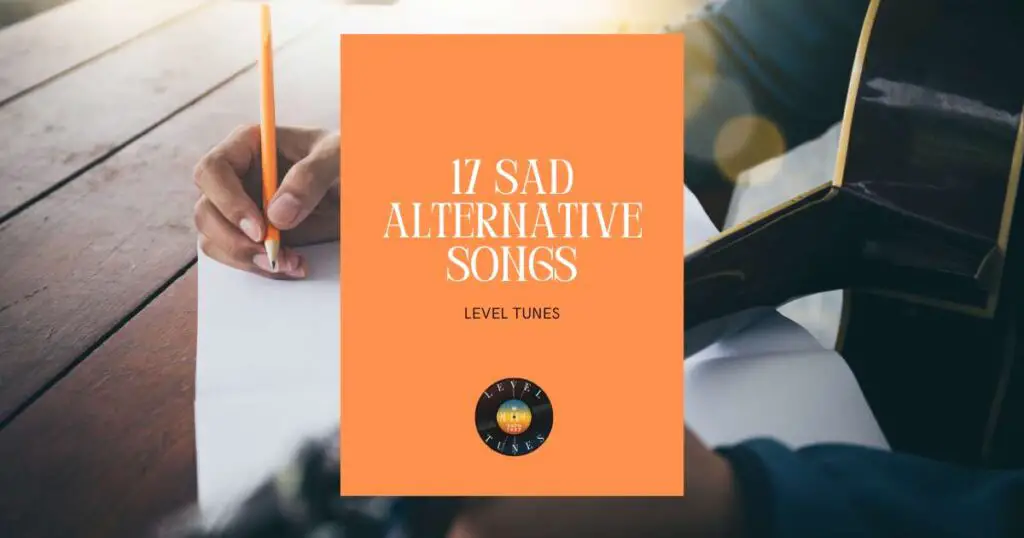17 Sad Alternative Songs: Cry It Out
Hey there, fellow music enthusiasts! It’s TBone here, your go-to DJ and proud owner of Level Tunes.
Having spent over 20 incredible years in the music industry, I’ve had the pleasure of exploring various genres and sharing them with all of you. Today, I’m diving into something that holds a special place in my heart: sad alternative songs.
There’s something uniquely cathartic about this genre, a way it speaks to the soul and evokes emotions like no other.
I’ve handpicked 17 tracks that have not only moved me but also stand as testaments to the power of music in expressing the depth of human emotions.
Whether you’re a DJ looking to add some emotional depth to your sets, or a music lover seeking solace in sound, this list is for you. Let’s explore these hauntingly beautiful tunes together, and remember, it’s okay to feel.
Here are the sad alternative songs that you can check out:
List Of Sad Alternative Songs
Sad Alternative songs in a list format:
1. “Skinny Love” by Bon Iver
“Skinny Love” is a track that stands out in Bon Iver’s discography, featured on their 2007 album “For Emma, Forever Ago,” released under the Jagjaguwar label. This song, penned by Justin Vernon during a secluded winter in Wisconsin, captures the fragility of love and the pain of its dissolution. The raw acoustic guitar paired with Vernon’s haunting falsetto creates a chilling yet beautiful atmosphere. I chose this song for its simplicity and emotional depth, which showcases Vernon’s ability to convey profound feelings with minimal instrumentation. The stripped-back nature of “Skinny Love” highlights the song’s heartfelt lyrics and Vernon’s unique vocal style, making it a timeless piece in the alternative genre.
2. “The Night We Met” by Lord Huron
From the 2015 album “Strange Trails” under the IAMSOUND Records label, “The Night We Met” by Lord Huron is a hauntingly beautiful song that speaks of regret and longing. The melancholic melody, combined with Ben Schneider’s evocative lyrics, captures the essence of wishing to return to a moment in the past. The inclusion of this song in the soundtrack of “13 Reasons Why” amplified its emotional impact. What draws me to “The Night We Met” is its ability to transport listeners to a specific time and place, wrapped in the bittersweet memory of lost love. The atmospheric instrumentation and Schneider’s yearning vocals make it a standout track for anyone who’s ever wished for a second chance.
3. “Hurt” by Johnny Cash
Johnny Cash’s rendition of “Hurt,” originally by Nine Inch Nails, was released on his 2002 album “American IV: The Man Comes Around” under American Recordings. This song marks a profound moment in Cash’s career, reflecting on his life, legacy, and the inevitability of mortality. Cash’s gravelly voice, laden with the weight of experience, brings a new level of depth and poignancy to the lyrics, differentiating it from the original. I selected this song for its raw emotional power and Cash’s ability to make the song his own, transforming it into a poignant reflection on life and loss. The minimalist arrangement and Cash’s heartfelt delivery make “Hurt” a deeply moving experience.
4. “No Surprises” by Radiohead
Featured on their 1997 album “OK Computer,” released under the Parlophone label, “No Surprises” by Radiohead is a lullaby of despair set against the backdrop of modern life’s monotony and disillusionment. Thom Yorke’s delicate vocals, combined with the song’s gentle melody, contrast sharply with the dark themes of alienation and longing for escape. I admire how Radiohead crafts a sound that is both ethereal and deeply grounded in emotional truth. The song’s intricate instrumentation and Yorke’s poignant lyrics encapsulate the band’s critique of contemporary society, making “No Surprises” a masterpiece of alternative music that resonates with listeners seeking solace from the pressures of life.
5. “Black” by Pearl Jam
“Black,” from Pearl Jam’s debut album “Ten” (1991), released through Epic Records, remains one of the band’s most beloved tracks. Eddie Vedder’s powerful vocals tell a story of love lost and the haunting permanence of memory. The song’s emotional depth is amplified by its dynamic composition, from the delicate opening guitar riff to the soaring climax. What captivates me about “Black” is its raw honesty and the intensity of Vedder’s performance, which convey the profound sense of longing and loss. Pearl Jam’s ability to blend rock elements with such vulnerable storytelling makes “Black” a seminal track in the alternative genre.
6. “Fake Plastic Trees” by Radiohead
Another gem by Radiohead, “Fake Plastic Trees” from their 1995 album “The Bends,” released under Parlophone, showcases the band’s knack for melding melancholy lyrics with lush, atmospheric soundscapes. Thom Yorke’s emotive delivery of lyrics critiquing artificiality and superficiality in society is matched by the song’s sweeping arrangement. I’m drawn to “Fake Plastic Trees” for its poignant commentary and the emotional resonance of its melody. The song’s build-up from a simple acoustic opening to a powerful, full-band crescendo exemplifies Radiohead’s musical versatility and ability to touch on universal themes with profound sensitivity.
7. “Sometime Around Midnight” by The Airborne Toxic Event
From their self-titled 2008 album, released via Majordomo Records, “Sometime Around Midnight” by The Airborne Toxic Event is an epic narrative of encountering an ex-lover and the overwhelming emotions that follow. The song’s orchestral build-up mirrors the escalating intensity of the protagonist’s feelings, making it a cathartic listen. Mikel Jollett’s vivid storytelling and the
emotional swell of strings and electric guitar create a cinematic experience. I chose this song for its storytelling prowess and the way it captures the universal experience of heartbreak and longing. The Airborne Toxic Event’s ability to combine rock elements with orchestral grandeur gives “Sometime Around Midnight” a unique place in alternative music, resonating deeply with anyone who’s ever felt the sting of lost love in the pit of their stomach.
8. “Colorblind” by Counting Crows
Featured on their 1999 album “This Desert Life,” released under Geffen Records, “Colorblind” by Counting Crows is a poignant ballad that speaks to vulnerability and the desire for acceptance. Adam Duritz’s tender vocals, accompanied by the simple yet stirring piano melody, evoke a sense of intimacy and raw emotion. This song captured my heart for its honesty and the beautiful way it conveys the feeling of exposing one’s true self, warts and all. Counting Crows have a knack for crafting songs that touch on the human condition, and “Colorblind” is a prime example of their ability to weave complex emotions into music that’s both accessible and deeply meaningful.
9. “Lua” by Bright Eyes
Conor Oberst, with his project Bright Eyes, released “Lua” on the 2005 album “I’m Wide Awake, It’s Morning,” under Saddle Creek Records. This acoustic ballad delves into themes of loneliness, substance abuse, and the complexities of relationships. Oberst’s storytelling is at its finest here, with evocative lyrics and a delicate melody that draws listeners into the narrative. “Lua” stands out to me for its stark simplicity and the emotional vulnerability Oberst brings to his performance. The song’s raw, unfiltered look at human frailty and the search for connection makes it a standout track in the alternative folk genre.
10. “The Scientist” by Coldplay
From their 2002 album “A Rush of Blood to the Head,” released by Parlophone, “The Scientist” by Coldplay is a heartfelt ballad that combines a simple piano line with Chris Martin’s emotive vocals to explore themes of regret and longing for a second chance. The song’s structure, with its gradual build-up and poignant lyrics, showcases Coldplay’s talent for creating anthemic yet deeply personal tracks. I’m drawn to “The Scientist” for its universal message of love and loss, and the way it encourages reflection and connection. The song’s beautifully shot reverse-narrative music video further amplifies its emotional impact, making it an unforgettable piece in Coldplay’s catalogue.
11. “Disarm” by The Smashing Pumpkins
“Disarm” appears on The Smashing Pumpkins’ 1993 album “Siamese Dream,” released through Virgin Records. This track stands out for its striking use of orchestral elements and Billy Corgan’s poignant lyrics, which reflect on childhood trauma and the loss of innocence. The combination of acoustic guitar, strings, and glockenspiel, alongside Corgan’s raw vocal delivery, creates a powerful emotional resonance. I chose “Disarm” because it exemplifies the band’s ability to tackle heavy themes with musical sophistication and emotional depth. The Smashing Pumpkins’ knack for blending rock with orchestral arrangements makes “Disarm” a timeless track that continues to move listeners with its vulnerability and honesty.
12. “Wish You Were Here” by Pink Floyd
From the iconic 1975 album of the same name, released by Harvest Records, “Wish You Were Here” by Pink Floyd is a timeless ode to absence and longing. This song, written as a tribute to former bandmate Syd Barrett, showcases Pink Floyd’s masterful blend of lyrical depth and musical innovation. The acoustic guitar intro, ethereal slide guitar, and Roger Waters’ reflective vocals create a sense of melancholy and introspection. “Wish You Were Here” resonates with me for its exploration of the themes of disconnection and the desire for reunion, making it a profound statement on the human condition and the bonds that tie us together, even in absence.
13. “How to Save a Life” by The Fray
Released on their 2005 debut album of the same name under Epic Records, “How to Save a Life” by The Fray became an anthem for a generation grappling with themes of intervention, loss, and misunderstanding. Isaac Slade’s heartfelt piano and vocals narrate the struggle of reaching out to someone in crisis. This song is special to me for its emotive storytelling and the way it has connected with so many listeners, offering solace and understanding. The Fray’s ability to craft a song that is both personal and universally relatable is a testament to their songwriting prowess, making “How to Save a Life” a key track in the alternative rock landscape.
14. “Creep” by Radiohead
“Creep,” released on Radiohead’s 1993
debut album “Pablo Honey” under Parlophone Records, is a song that defined the ’90s alternative rock scene. Thom Yorke’s lyrics about feeling out of place and longing for acceptance, combined with Jonny Greenwood’s distinctive guitar crunch, create a track that’s raw, vulnerable, and utterly relatable. What draws me to “Creep” is its unabashed honesty and the way it speaks to the outsider in all of us. The song’s gritty realism and emotional depth showcase Radiohead’s early ability to tap into the collective consciousness, making “Creep” a powerful anthem for those who have ever felt overlooked or misunderstood.
15. “Holocene” by Bon Iver
“Holocene” from Bon Iver’s 2011 album “Bon Iver, Bon Iver,” released by Jagjaguwar, is a beautifully crafted song that explores themes of insignificance and awe within the vastness of the world. Justin Vernon’s ethereal vocals and the intricate instrumentation create a soundscape that’s both haunting and uplifting. The song’s title, referring to a geological epoch, hints at the timeless and expansive nature of the human experience. I’m captivated by “Holocene” for its poetic lyrics and the way it encourages a deep connection with the natural world and our place within it. Bon Iver’s ability to blend folk elements with experimental sounds makes this track a mesmerizing piece of art that resonates on a profound level.
16. “Leave Out All the Rest” by Linkin Park
Featured on their 2007 album “Minutes to Midnight,” released under Warner Bros. Records, “Leave Out All the Rest” by Linkin Park shows a different side of the band known for their nu-metal roots. This song delves into themes of legacy and the desire to be remembered fondly after death. Chester Bennington’s heartfelt vocals, alongside the band’s melodic approach, showcase Linkin Park’s versatility and ability to address deep emotional and existential concerns. I admire “Leave Out All the Rest” for its introspective lyrics and the band’s commitment to exploring new musical territories, making it a standout track that offers a sense of solace and understanding.
17. “Brick” by Ben Folds Five
“Brick” is a poignant song from Ben Folds Five’s 1997 album “Whatever and Ever Amen,” released by 550 Music. This ballad stands apart for its frank discussion of a difficult topic—abortion—told through the lens of a personal experience. Ben Folds’ narrative songwriting and the sparse, emotional piano work convey a sense of intimacy and vulnerability. What resonates with me about “Brick” is its raw honesty and the way it tackles a complex issue with sensitivity and depth. Ben Folds Five’s ability to create a song that is both deeply personal and universally impactful is why “Brick” remains an important and moving piece in the alternative music scene.
Fun Facts: Sad Alternative Songs
“Skinny Love” by Bon Iver
- Recording in Solitude: Justin Vernon recorded “Skinny Love” and the rest of the “For Emma, Forever Ago” album in a remote cabin in Wisconsin during the winter. This isolation contributed to the raw, emotional depth of the song.
“The Night We Met” by Lord Huron
- Time Travel Feel: Many fans and critics have noted that “The Night We Met” has a timeless quality, making listeners feel as if they’re traveling through time. This effect aligns perfectly with its use in “13 Reasons Why,” where characters literally wish to turn back time.
“Hurt” by Johnny Cash
- Trent Reznor’s Approval: Originally by Nine Inch Nails, Trent Reznor was initially unsure about Johnny Cash covering “Hurt.” However, upon seeing the music video, Reznor admitted that the song wasn’t his anymore, highlighting Cash’s powerful reinterpretation.
“No Surprises” by Radiohead
- One-Breath Challenge: Thom Yorke recorded the vocals for “No Surprises” in one breath, adding to the song’s feeling of suffocation and despair. This technique emphasizes the song’s themes of overwhelming pressure and desire for escape.
“Black” by Pearl Jam
- Eddie Vedder’s Raw Emotion: Vedder has mentioned that “Black” is a song he finds difficult to perform live due to its emotional depth and personal significance, highlighting the genuine pain and loss conveyed in the lyrics.
“Fake Plastic Trees” by Radiohead
- Thom Yorke’s Emotional Recording: After recording the vocals for “Fake Plastic Trees,” Thom Yorke reportedly broke down in tears, showcasing the emotional toll and intensity of the song’s message about authenticity and disillusionment.
“Sometime Around Midnight” by The Airborne Toxic Event
- Literary Inspiration: Mikel Jollett, the band’s lead singer and writer of the song, was inspired by his own experiences and literary influences, making “Sometime Around Midnight” a fusion of personal narrative and poetic storytelling.
“Colorblind” by Counting Crows
- Popular in Film and TV: “Colorblind” has been featured in several films and TV shows, most notably in the movie “Cruel Intentions,” where it underscores a pivotal and emotional moment, enhancing its impact on audiences.
“Lua” by Bright Eyes
- Acoustic Simplicity: Conor Oberst performed “Lua” using just his voice and an acoustic guitar, showcasing the power of minimalistic arrangements to convey deep emotional narratives about addiction and loneliness.
“The Scientist” by Coldplay
- Backwards Video Concept: The music video for “The Scientist” is notable for its unique concept, where Chris Martin is seen singing the lyrics backwards while the video plays in reverse, a technique that required Martin to learn the song’s lyrics in reverse.
“Disarm” by The Smashing Pumpkins
- Controversial Lyrics: “Disarm” was controversial upon its release due to its emotionally charged lyrics about childhood trauma. The song faced radio bans but ultimately became one of the band’s most beloved tracks.
“Wish You Were Here” by Pink Floyd
- Syd Barrett’s Surprise Visit: During the recording of “Wish You Were Here,” Syd Barrett, the song’s muse, unexpectedly visited the studio. His appearance was so changed that some band members initially did not recognize him, adding a layer of poignancy to the song’s message.
“How to Save a Life” by The Fray
- Inspired by Real-Life Experience: Isaac Slade wrote the song after his experience working at a camp for troubled teens, making “How to Save a Life” a reflection on the challenges and rewards of reaching out to someone in need.
“Creep” by Radiohead
- Legal Issues: “Creep” faced legal action for its similarity to The Hollies’ song “The Air That I Breathe.” Radiohead agreed to credit Albert Hammond and Mike Hazlewood as co-writers, highlighting the song’s complicated legacy.
“Holocene” by Bon Iver
- Grammy Recognition: Despite its indie roots, “Holocene” was nominated for Record of the Year and Song of the Year at the Grammy Awards, indicating its wide-reaching impact and acclaim.
“Leave Out All the Rest” by Linkin Park
- Addressing Mortality: The song reflects Chester Bennington’s thoughts on his own legacy and how he wished to be remembered, a theme that has become more poignant following his passing.
“Brick” by Ben Folds Five
- Breaking Taboos: “Brick” was one of the first songs in the pop-rock genre to deal openly with the topic of abortion, making it a groundbreaking track that sparked discussions about difficult subjects through music.
Diving into these 17 sad alternative songs reveals the profound power of music to touch our hearts and souls. Each track, with its unique story and emotional depth, offers a cathartic journey through the complexities of human emotion. Join me, TBone, as we explore the beauty in the melancholy together.
Thanks for reading.
TBone




